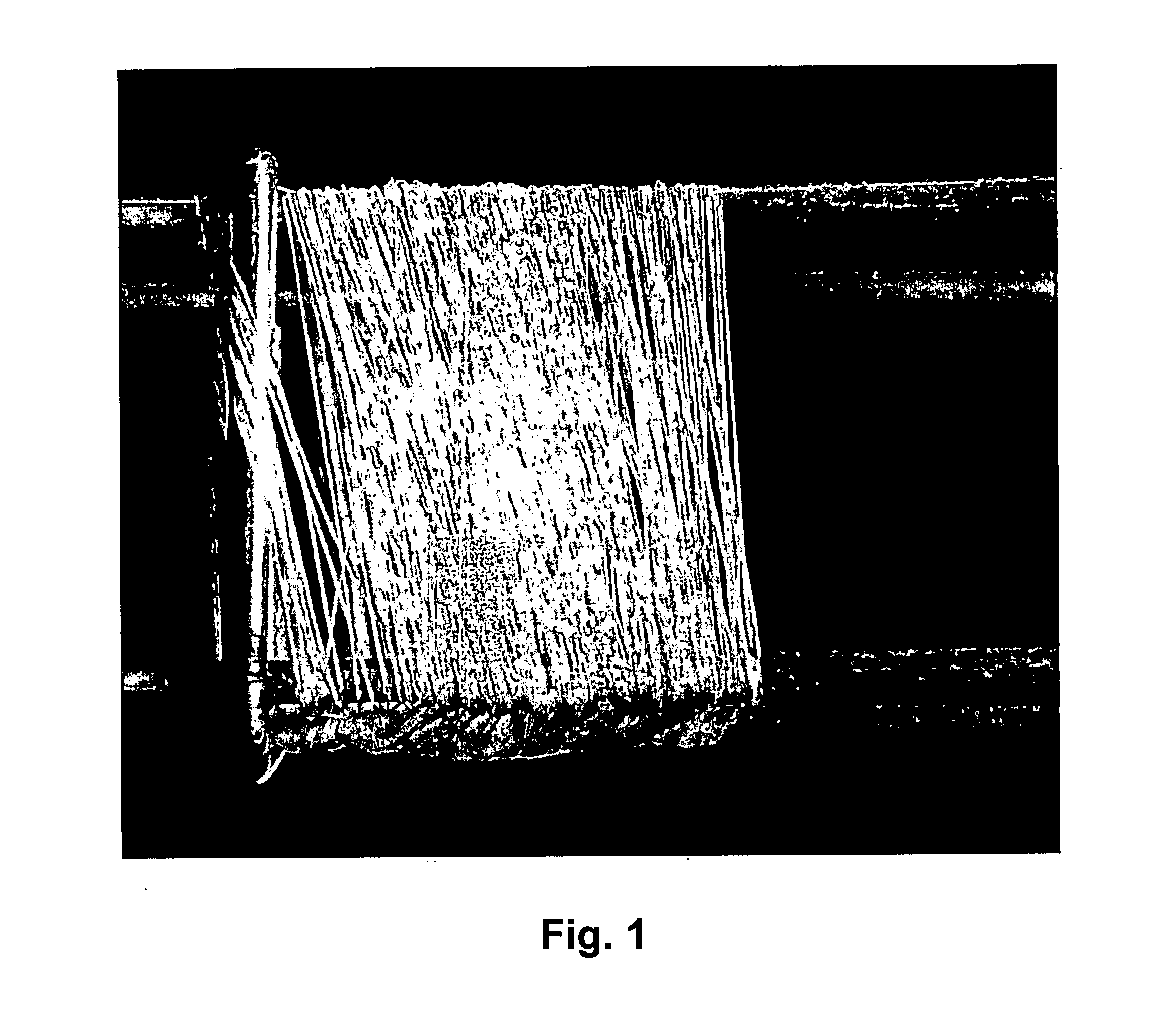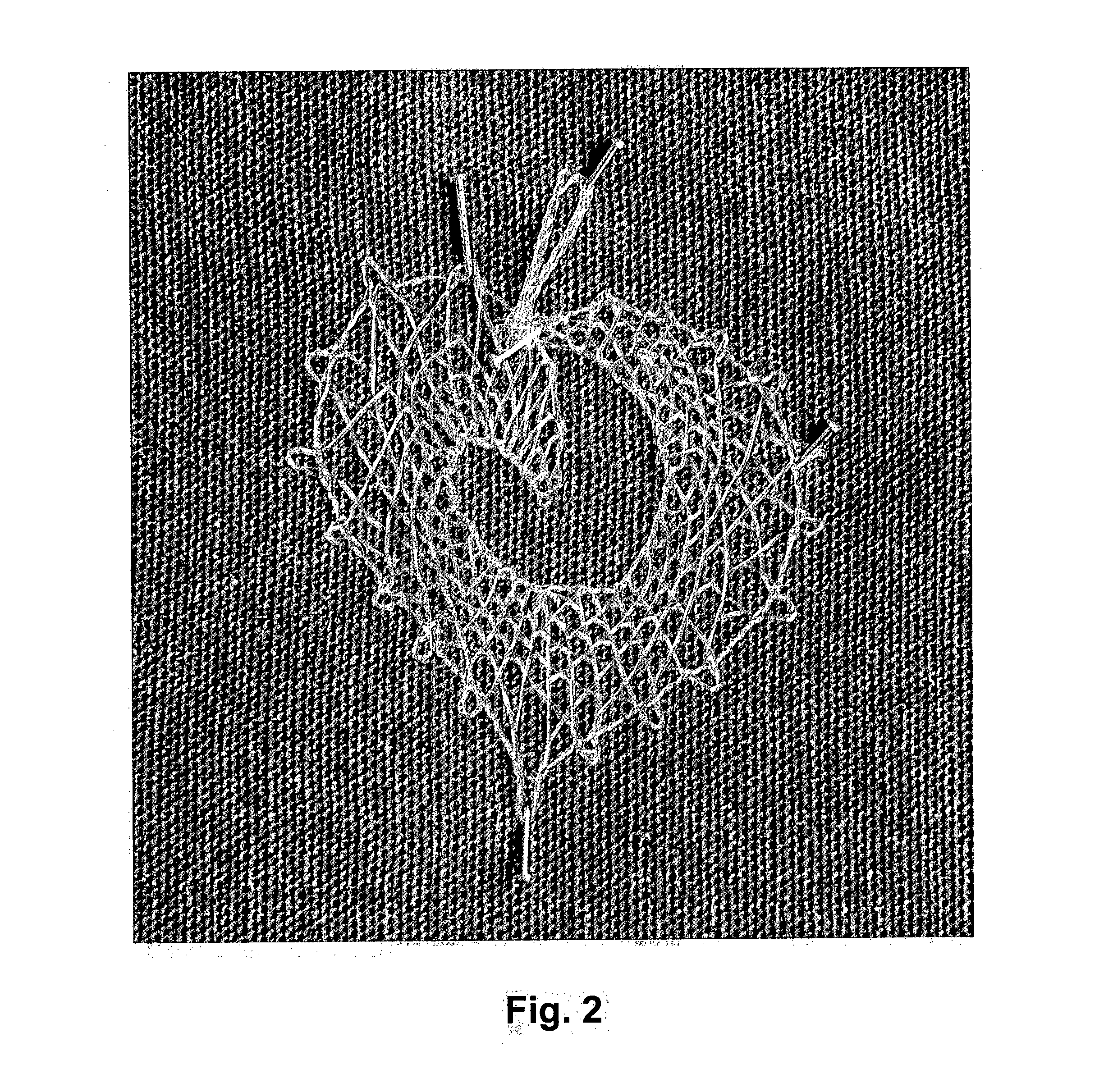Hyaluronan fibres, method of preparation thereof and use thereof
- Summary
- Abstract
- Description
- Claims
- Application Information
AI Technical Summary
Benefits of technology
Problems solved by technology
Method used
Image
Examples
example 1
[0071]Under inert atmosphere (helium, nitrogen), at intensive stirring, 6 grams of sodium hyaluronate (CPN s.r.o., Dolní Dobrou{hacek over (c)}, Czech Republic) having the molecular weight of 1.7 MDa (determined by SEC-MALLS method) was dissolved in 94 g of water, with the addition of 0.64 g of NaOH, until a homogeneous, well flowing viscous solution was obtained. This solution was spun through an industrial nozzle used for example for spinning the cellulose xanthogenate solution. The nozzle has 24 outlets of the diameter of 0.2 mm. The wet spinning was carried out. As the precipitation (coagulation, spinning) bath, the mixture of 700 ml of ethanol p.a. and 300 ml of pure 98% formic acid was used. A non-drawn fibre was obtained, which, after 40 minutes of standing in the coagulation bath, was drawn by 50% and washed with methanol. A cable of silk was obtained, having 24 elementary fibres of the diameter of 22.5 μm.
example 2
[0072]Under air atmosphere, at intensive stirring, 6 grams of sodium hyaluronate (CPN s.r.o., Dolní Dobrou{hacek over (c)}, Czech Republic) having the molecular weight of 1.7 MDa (determined by SEC-MALLS method) was dissolved in 94 g of water with the addition of 0.51 g of NaOH, until a homogeneous, well flowing viscous solution suitable for spinning was obtained. This solution was spun by the wet spinning method with a nozzle of a diameter of 0.4 mm into the coagulation bath consisting of: 650 ml of methanol p.s. and 350 ml of pure 98% formic acid. The flow rate of the spinning solution through the nozzle was 6 cm3·min−1. A non-drawn fibre was obtained and, after 40 minutes of standing in the coagulation bath, a part thereof was drawn by 50% and then washed with methanol, in a similar way as the non-drawn fibre. A monofilament (an individual elementary fibre) was obtained and its strength, in case of drawing, was 1.635 mN·dtex−1 and ductility 8% after conditioning at the relative h...
example 3
[0073]Under air atmosphere, at intensive stirring; 6 grams of sodium hyaluronate (CPN s.r.o., Dolní Dobrou{hacek over (c)}, Czech Republic) having the molecular weight of 1.7 MDa (determined by SEC-MALLS method) was dissolved in 94 g of water with the addition of 0.51 g of NaOH, until a homogeneous, well flowing viscous solution suitable for spinning was obtained. This solution was spun by the wet spinning method with a nozzle of the diameter of 0.4 mm into a coagulation bath consisting of: 700 ml of methanol p.s. and 300 ml of pure 98% formic acid. A non-drawn fibre was obtained. A part of this fibre was drawn by 70% after 15 minutes of standing, the second part of the fibre was drawn by 70% after standing in the coagulation bath for 40 min. The sample which was left in the bath for 40 min. shows the strength of 1.647 cN·dtex−1 (at the relative humidity of 65%) and ductility of 8%, compared to the sample having stayed for 15 min. only, where the strength of 0.945 cN·dtex−1 and duct...
PUM
| Property | Measurement | Unit |
|---|---|---|
| Temperature | aaaaa | aaaaa |
| Temperature | aaaaa | aaaaa |
| Length | aaaaa | aaaaa |
Abstract
Description
Claims
Application Information
 Login to View More
Login to View More - R&D
- Intellectual Property
- Life Sciences
- Materials
- Tech Scout
- Unparalleled Data Quality
- Higher Quality Content
- 60% Fewer Hallucinations
Browse by: Latest US Patents, China's latest patents, Technical Efficacy Thesaurus, Application Domain, Technology Topic, Popular Technical Reports.
© 2025 PatSnap. All rights reserved.Legal|Privacy policy|Modern Slavery Act Transparency Statement|Sitemap|About US| Contact US: help@patsnap.com



